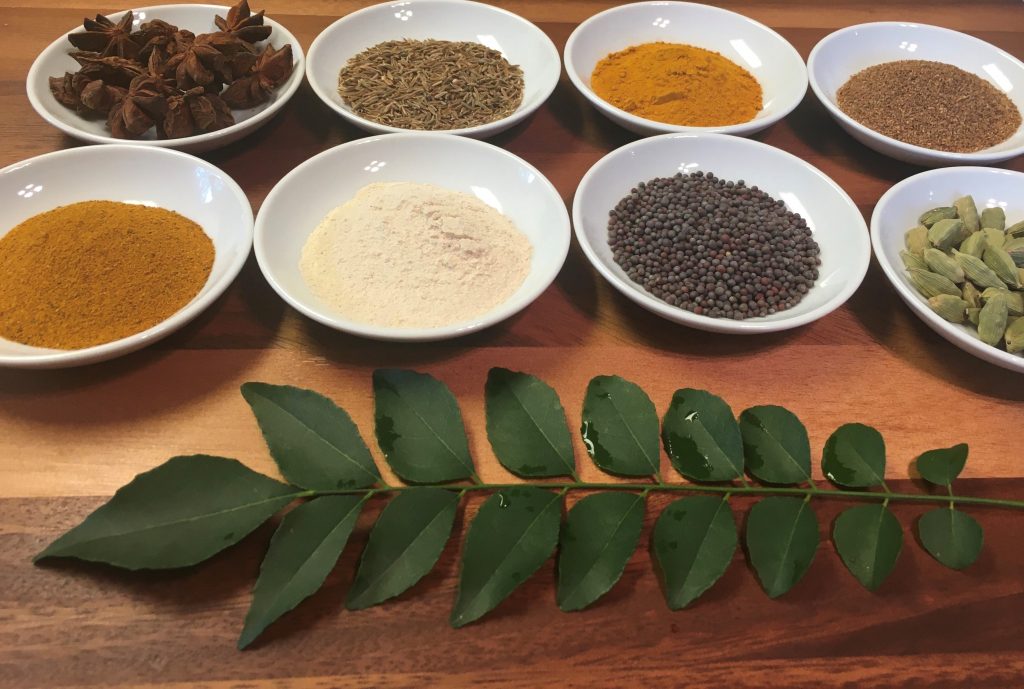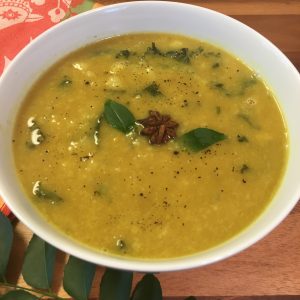10 Ways to Celebrate the Healing Power of Spices

Looking for a soup to warm you, body and soul? Then look no further than this Curried Cauliflower Soup, which serves as a great introduction to the healing power of spices.
After a week of frigid weather in North Carolina, we’re definitely craving hot soup for dinner. Although the cherry trees in our neighborhood were already starting to bloom, as they were apparently confused by a few weeks of 65 to 70 degrees!
To many readers, nothing says “hot” quite like “curry,” but if you don’t enjoy heavily spiced foods—because, like me, you avoid cayenne pepper—you may be pleasantly surprised how much you’ll love this cauliflower soup. Why? Because this recipe has built-in flexibility from delicately flavored to spicy hot. Although “curry” usually signals fiery hot, when I cook, I leave the cayenne out altogether—but you can certainly add as much as you enjoy. A curry is simply any Indian-spiced dish with a mélange of spices that are cooked in water and fat to create a gravy, or in this case, a soup.
If you do eat a lot of cayenne and chilies, be advised that they cause all kinds of havoc when eaten in excess. From an Ayurvedic perspective, they increase both vata and pitta problems:
- Acid reflux? Check.
- Heartburn? Check.
- IBS? Check.
- Irritability? Check.
- Skin problems? Check.
- Sleep disorder? Check.
- Depression and anxiety? Check.
As I’ve written before, the use of chilies and cayenne pepper was never part of traditional Ayurvedic cuisine, as chilies were only introduced to India by the Portuguese navigators in the 16th century. However, the use of various healing spices has been the hallmark of Ayurvedic cooking for five thousand years or more. You’ll see these wonderful, subtle flavors in today’s recipe.
NOTE: Spices 1 through 4 are pictured above in the top row, left to right.
1. Star Anise aids digestion and is good for the respiratory system. If it’s not available, you can substitute with ½ teaspoon ground fennel seed. I often use star anise instead of fennel because it’s pretty as well as flavorful! If you’re not familiar with star anise or fennel, they both have a flavor similar to licorice. If you dislike that taste, feel free to leave it out, though this recipe only creates a hint of this spice’s flavor.
2. Cumin promotes digestion by increasing agni, the body’s digestive fire. Cumin’s taste is slightly pungent and bitter, and its effect is mildly cooling without increasing vata or kapha. Cumin digests toxins, lowers vata, alleviates intestinal spasms and vomiting, benefits intelligence, and clears the head of mucus and congestion. Eaten in excess, cumin will increase pitta because of its pungent quality.
3. Turmeric kindles agni and is studied in Western science for its antibacterial, anti-inflammatory, and antioxidant properties. It has recently been proven to play a preventative role in colon cancer. Turmeric purifies the blood, stops itching and supports healing of skin diseases. Is also used in Ayurveda to destroy ama (toxins), worms, and fever. It is useful in treating diabetes, gallstones, and liver problems. This is the short list! Whole books have been written about the healing properties of turmeric. Nonetheless, one can take too much turmeric, which will increase pitta (as turmeric is heating) and will increase vata (as turmeric is drying). Vaidya R.K. Mishra suggests too much turmeric can even cause a “detox crisis,” if the body is not properly prepared in advance for detoxification. Ayurveda recommends cooking only with the dried, powdered form of turmeric, mixed with water and fat. Adding dried or raw turmeric to salads or as an uncooked topping to cooked dishes is considered an inappropriate use of turmeric, according to some respected Ayurvedic practitioners, as is eating raw turmeric root.
4. Coriander kindles agni without increasing pitta, because it is cooling. It’s the perfect balance to the heating spices in any dish while also promoting good digestion. It also helps digest toxins, alleviates thirst, and lifts the spirits!
NOTE: Spices 5 through 9 are pictured above in the top row, left to right.
5. Curry powders are as varied as there are spice manufacturers and Indian households. They contain several and up to twenty spices, including ground cayenne and turmeric, which give curries their golden color. All commercial curry powders range from hot to hotter, which means a little goes a long way. Curry powder tends to be excellent for kapha types and kapha problems, such as congestion. In excess curry will aggravate vata and pitta problems. Cayenne makes me itch—a pitta problem, for sure!
6. Asafetida (hing) is heating and an excellent spice for calming vata and kapha, but it should only be used in near miniscule amounts, or it becomes toxic to the body as well as increasing pitta. It helps clear vata in the digestive tract, treating bloating, flatulence, and intestinal pain, so recipes using hard legumes often call for asafetida. It is used in Ayurvedic medicine to clear ama and is used to treat cough and asthma as well as for high vata conditions such as paralysis, sciatica, and epilepsy. If you are gluten-intolerant, you will need to read the label. Most asafetida (also spelled asafoetida) sold in Asian grocery stores is cut with gluten. The Savory Spice chain sells gluten-free asafetida.
7. Black mustard seeds are pungent and bitter with a heating effect. They stimulate agni, warm the digestive system, and clear sluggish congestion. They are also used in Ayurvedic medicines to treat lung problems, arthritis, and to clear ama.
8. Cardamom, shown here as cardamom pods, is both pungent and sweet with a cooling effect. Cardamom is good for all doshas though in excess will increase pitta because of its pungent quality. Cardamom is excellent for stimulating digestion and treating flatulence, colic, and intestinal pain. I used the pods in this recipe to give a hint of flavor. Most people would not enjoy biting into a whole pod! If you wish, you can open the pod and crush the seeds for a more intense flavor.
9. Curry leaves have a wonderful aromatic flavor to add to soups, stews, and Indian curries. They are sweet, astringent, and pungent, and according to Dr. Vasant Lad, they are fine for all doshas. They are used medicinally in Ayurveda to support digestion and lower blood sugar.
10. Black pepper was also added to this recipe, not only to make it an even 10! Black pepper makes a curry taste more like curry if you’re not using cayenne, and it helps digest the cauliflower. Black pepper is a heating spice that pacifies vata and kapha, and when used in moderation, will not be overp0wering for pitta. Even so, people with pitta problems benefit from avoiding pepper during the warm summer months. Black pepper stimulates agni and helps increase enzyme secretion for the digestive process. It is used medicinally in Ayurvedic treatments for sluggish digestion, abdominal pain, anorexia, lung conditions, and to help remove worms.
Enjoy using some or all of these ancient spices in this timeless Curried Cauliflower Soup!





